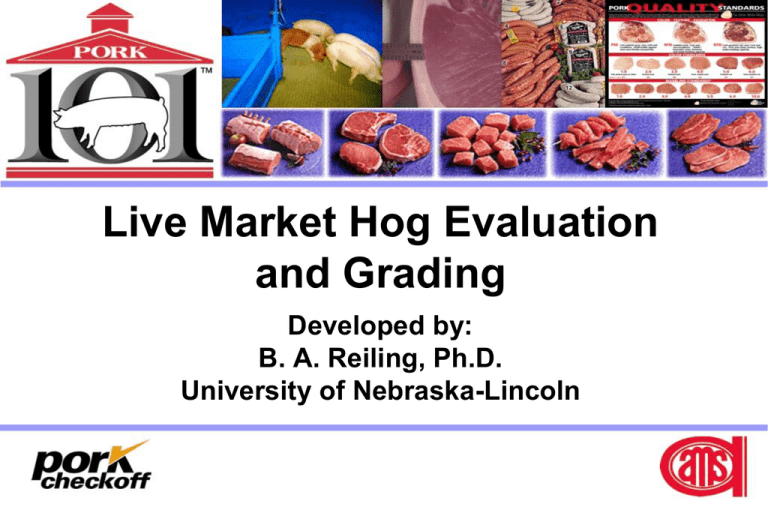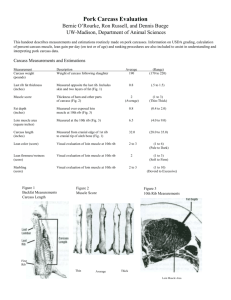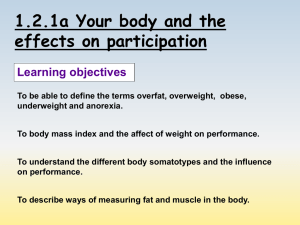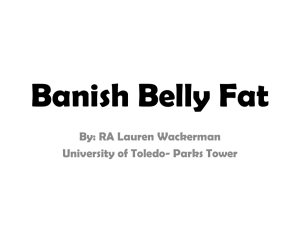
Live Market Hog Evaluation
and Grading
Developed by:
B. A. Reiling, Ph.D.
University of Nebraska-Lincoln
Visual Evaluation
•
•
•
•
•
Subjective
Less accurate than real-time ultrasound
Less expensive, more convenient
Still important for selection decisions
Still important for marketing decisions
Value-determining Traits
• Weight
– Live weight (LW)
– Carcass weight (HCW)
• Dressing Percent (DP)
– Relates LW to HCW
– HCW = LW X DP
• Leanness
– 10th rib fat thickness
– Last rib fat thickness
• Muscle
– Loin muscle area
– USDA muscle score
Average Values
• Live Weight
– Range: 230 – 300 lbs
– Average: 272 lbs
• Dressing Percentage
– Range: 68 – 78%
– Average: 75%
– Affecting factors
• Fill, muscle, fat
• Carcass Weight
– = LW * DP
– ~ 200 lbs
• Length
–
–
–
–
First rib to aitch bone
Shoulder point to ham
Range: 28-34 in
Avg:
31 in ()
How Do Animals Get Fat?
• Top to Bottom
• Front to Rear
• Gender Effects
– Gilts leaner than barrows
Body Shapes – Rear View
• Heavy muscled hogs are wide based
Desirable
Undesirable
Body Shapes – Top View
• Lean hogs = “hourglass shape”
• Fat hogs = “boat shape”
Desirable
Undesirable
Evaluation of Fat Deposition
1) Jowl
2) Blades
3) Forerib
7
4) Elbow pocket 7) Tail head
5) Loin edge
8) Ham seam
6) Flank
5
5
3
6
4
2
1
8
Average Values
• Last rib fat thickness
– Used for calculation of lean content in the industry
• 10th rib fat thickness
–
–
–
–
–
¾ length of the eye muscle; corresponds with “loin edge”
Used to calculate % muscle
Range: 0.35 – 1.2 in ()
Avg:
.7 in
But, carcasses are NOT ribbed
Last Rib vs.
th
10
Rib Backfat
Last rib BF, in.
10th rib BF, in.
.60
.45
.80
.80
1.00
1.20
1.20
1.55
1.40
1.95
Lean Hog
Fat Hog
How Lean? How Fat?
Wt = 247 lbs
Wt = 252 lbs
How Lean? How Fat?
LRF, in
0.60
LRF, in
1.00
10th rib fat, in 0.30
10th rib fat, in 1.60
LEA, sq in
LEA, sq in
% Lean
9.50
63.16
% Lean
4.50
39.82
Evaluation of Muscle
1) Shoulder
2) Forearm
3) Loin (top)
4) Ham/stifle
3
1
4
Thick Ended
2
Average Values
• Loin Eye Area (LEA)
– Loin Muscle Area (LMA)
– Longissimus dorsi
– Ultrasound measure
– Range: 4.5 – 10.0 in2
– Avg: ~ 6.0 in2 ()
USDA Carcass Grading
Two Factors:
• Last rib backfat (LRBF)
• Muscle Score (MS)
– Thick = 3
– Average = 2
– Thin = 1
• = (4 * LRBF) – MS
– Thin muscled hogs
ineligible for USDA #1
USDA Muscle Scores
Thin = 1
Average = 2
Thick = 3
Cutability Values
• Various equations to predict % muscle (lean)
– May include 0 (fat-free), 5 (marbling), or 10% fat
• Observations
– As live weight , % muscle
– As fat cover , % muscle
– As LEA , % muscle
Critical Factors = Fat Cover and Weight
Percentage Fat-Free Lean
•
• Can use ultrasound
• Pounds of fat-free lean:
– 250 lb live weight = base
.833 * Sex (barrow = 1, gilt = 2)
+ .291 * live weight, lbs
- 16.498 * 10th rib fat, in
+ 5.425 * LMA, in2
.534
Convert percentage lean
pounds of fat-free lean
live weight
Short-cut Method
X 100
• For every 10 lbs below; add 0.2%
• For every 10 lbs above; subtr 0.2%
– 0.8 inches 10th rib fat = base
• For every 0.1 in below; add 1%
• For every 0.1 in above; subtr 1%
– 5.5 in2 LMA = base
• For every 0.1 in above; add 0.2%
• For every 0.1 in below; subtr 0.2%
• Typical range: 48-60%
– Extremely lean pigs >60%
• With heavy-weight hogs
– Frame very important
Practice 1
Live Weight = 241 lbs
Dress %
Hot Carcass Wt
LRBF
10th Rib Fat
LEA
Muscle Score
USDA Grade
% Lean
77.6%
187 lbs
0.60 in
0.50 in
8.0 in2
2
0.4
58.1%
Practice 2
Live Weight = 274 lbs
Dress %
Hot Carcass Wt
LRBF
10th Rib Fat
LEA
Muscle Score
USDA Grade
% Lean
77.9%
214 lbs
1.00 in
1.05 in
7.4 in2
2
2.0
50.2%
Practice 3
Live Weight = 254 lbs
Dress %
Hot Carcass Wt
LRBF
10th Rib Fat
LEA
Muscle Score
USDA Grade
% Lean
73.0%
186 lbs
0.70 in
1.00 in
5.9 in2
2
0.8
48.9%
Let’s Look at Some Live Pigs!










